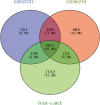Identification of PI3K-AKT Pathway-Related Genes and Construction of Prognostic Prediction Model for ccRCC
- PMID: 39233640
- PMCID: PMC11375326
- DOI: 10.1002/cnr2.70010
Identification of PI3K-AKT Pathway-Related Genes and Construction of Prognostic Prediction Model for ccRCC
Abstract
Background: Clear cell renal cell carcinoma (ccRCC), the predominate histological type of renal cell carcinoma (RCC), has been extensively studied, with poor prognosis as the stage increases. Research findings consistently indicated that the PI3K-Akt pathway is commonly dysregulated across various cancer types, including ccRCC. Targeting the PI3K-Akt pathway held promise as a potential therapeutic approach for treating ccRCC. Development and validation of PI3K-Akt pathway-related genes related biomarkers can enhance healthcare management of patients with ccRCC.
Purpose: This study aimed to identify the key genes in the PI3K-Akt pathway associated with the diagnosis and prognosis of CCRCC using data mining from the Cancer Genome Atlas (TCGA) and Gene Expression Synthesis (GEO) datasets.
Methods: The purpose of this study is to use bioinformatics methods to screen data sets and clinicopathological characteristics associated with ccRCC patients. The exhibited significantly differential expressed genes (DEGs) associated with the PI3K-Akt pathway were examined by KEGG. In addition, Kaplan-Meier (KM) analysis used to estimate the survival function of the differential genes by using the UALCAN database and graphPad Prism 9.0. And exploring the association between the expression levels of the selected genes and the survival status and time of patients with ccRCC based on SPSS22.0. Finally, a multigene prognostic model was constructed to assess the prognostic risk of ccRCC patients.
Results: A total of 911 genes with common highly expressed were selected based on the GEO and TCGA databases. According to the KEGG pathway analysis, there were 42 genes enriched in PI3K-Akt signalling pathway. And seven of highly expressed genes were linked to a poor prognosis in ccRCC. And a multigene prognostic model was established based on IL2RG, EFNA3, and MTCP1 synergistic expression might be utilized to predict the survival of ccRCC patients.
Conclusions: Three PI3K-Akt pathway-related genes may be helpful to identify the prognosis and molecular characteristics of ccRCC patients and to improve therapeutic regimens, and these risk characteristics might be further applied in the clinic.
Keywords: EFNA3; IL2RG; MTCP1; bioinformatics; clear cell renal cell carcinoma; prognostic model; the PI3K‐Akt signaling pathway.
© 2024 The Author(s). Cancer Reports published by Wiley Periodicals LLC.
Conflict of interest statement
The authors declare no conflicts of interest.
Figures







Similar articles
-
PLAUR facilitates the progression of clear cell renal cell carcinoma by activating the PI3K/AKT/mTOR signaling pathway.PeerJ. 2024 Jun 27;12:e17555. doi: 10.7717/peerj.17555. eCollection 2024. PeerJ. 2024. PMID: 38948215 Free PMC article.
-
TAGLN2 Promotes the Proliferation, Migration, Invasion, and EMT of Clear Cell Renal Cell Carcinoma Through the PI3K/Akt Signaling Pathway.Biochem Genet. 2023 Aug;61(4):1265-1281. doi: 10.1007/s10528-022-10319-z. Epub 2022 Dec 22. Biochem Genet. 2023. PMID: 36547768
-
Activation of PI3K is associated with reduced survival in renal cell carcinoma.Urol Int. 2008;80(4):372-7. doi: 10.1159/000132694. Epub 2008 Jun 27. Urol Int. 2008. PMID: 18587247
-
Significance of PI3K signalling pathway in clear cell renal cell carcinoma in relation to VHL and HIF status.J Clin Pathol. 2021 Apr;74(4):216-222. doi: 10.1136/jclinpath-2020-206693. Epub 2020 May 28. J Clin Pathol. 2021. PMID: 32467322 Review.
-
Decoding PTEN regulation in clear cell renal cell carcinoma: Pathway for biomarker discovery and therapeutic insights.Biochim Biophys Acta Rev Cancer. 2024 Sep;1879(5):189165. doi: 10.1016/j.bbcan.2024.189165. Epub 2024 Aug 6. Biochim Biophys Acta Rev Cancer. 2024. PMID: 39117092 Review.
Cited by
-
Exploring LAT-derived miRNAs as regulatory agents of EphrinA3 in glioblastoma multiforme.Biochem Biophys Rep. 2025 Jul 6;43:102132. doi: 10.1016/j.bbrep.2025.102132. eCollection 2025 Sep. Biochem Biophys Rep. 2025. PMID: 40688500 Free PMC article.
-
The 7-Methylguanosine (m7G) methylation METTL1 acts as a potential biomarker of clear cell renal cell carcinoma progression.Transl Oncol. 2025 Jan;51:102202. doi: 10.1016/j.tranon.2024.102202. Epub 2024 Nov 20. Transl Oncol. 2025. PMID: 39571491 Free PMC article.
References
-
- Sung H., Ferlay J., Siegel R. L., et al., “Global Cancer Statistics 2020: GLOBOCAN Estimates of Incidence and Mortality Worldwide for 36 Cancers in 185 Countries,” CA: A Cancer Journal for Clinicians 71, no. 3 (2021): 209–249. - PubMed
-
- Siegel R. L., Miller K. D., Fuchs H. E., and Jemal A., “Cancer Statistics, 2021,” CA: A Cancer Journal for Clinicians 71, no. 1 (2021): 7–33. - PubMed
-
- Gulati S. and Vaishampayan U., “Current State of Systemic Therapies for Advanced Renal Cell Carcinoma,” Current Oncology Reports 22, no. 3 (2020): 26. - PubMed
-
- Fisher R., Gore M., and Larkin J., “Current and Future Systemic Treatments for Renal Cell Carcinoma,” Seminars in Cancer Biology 23, no. 1 (2013): 38–45. - PubMed
MeSH terms
Substances
Grants and funding
LinkOut - more resources
Full Text Sources
Medical

